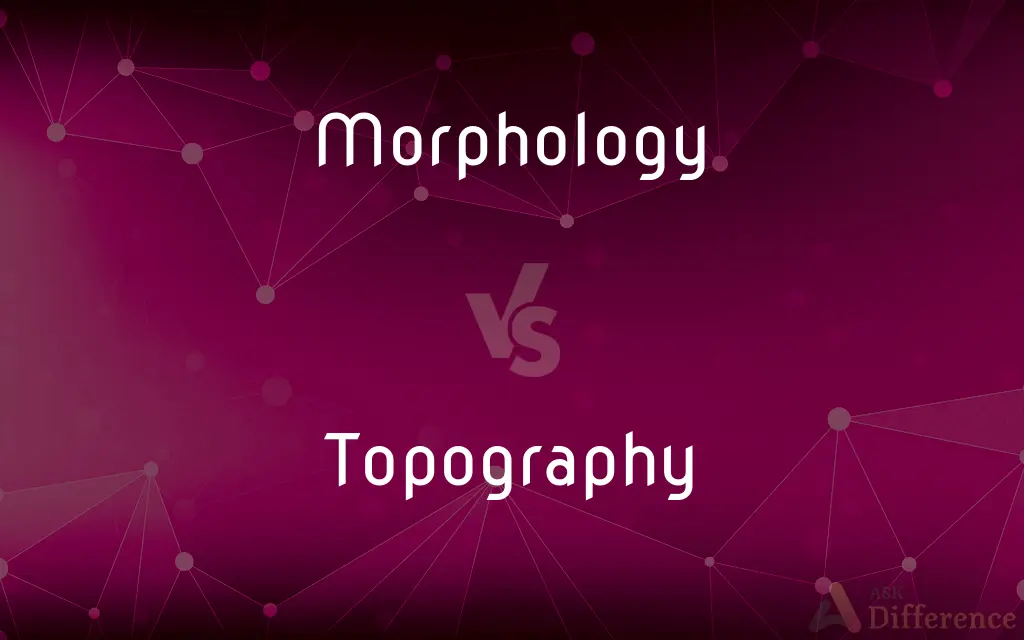Morphology vs. Topography — What's the Difference?
By Tayyaba Rehman — Updated on September 18, 2023
Morphology refers to the form or structure of something, often in linguistics or biology. Topography pertains to the physical features of land surfaces. While both involve structure, they apply to different fields.

Difference Between Morphology and Topography
Table of Contents
ADVERTISEMENT
Key Differences
Morphology, at its core, delves into the study of forms and the development of structures. In linguistics, it examines the structure of words and their parts. Topography, conversely, focuses on the physical layout of natural features on a land's surface, often illustrated with detailed maps.
While Morphology can be observed in various disciplines, like linguistics or biology (studying the form of living organisms), Topography stays rooted in geography and the detailing of landscapes, elevations, and physical land configurations.
A morphologist might investigate the structure of a word or the shape of an organism's body part. In contrast, a topographer will assess and record the arrangement of mountains, valleys, and rivers on a piece of land.
Maps are crucial for both disciplines but in different ways. Morphological studies might use tree diagrams to illustrate word formations in linguistics. Meanwhile, Topography produces detailed topographical maps that represent the elevation and contour of land.
Comparison Chart
Definition
Study of forms and structures.
Study of land's physical features and their representation.
ADVERTISEMENT
Main Applications
Linguistics, biology, geology.
Geography, mapping.
Tools & Representations
Tree diagrams (linguistics), microscopic imagery (biology).
Topographical maps.
Concerns
Word structures, biological forms.
Elevations, contours, physical land features.
Nature
Abstract or tangible structures depending on the field.
Physical and tangible.
Compare with Definitions
Morphology
Analysis of patterns and structures within languages.
Morphological studies can reveal the roots of a language.
Topography
Physical features of a particular location or region.
The topography of the desert is both vast and challenging.
Morphology
The external form and structure of a plant or creature.
The morphology of the plant indicated it was a succulent.
Topography
The description of a place's physical characteristics.
The topography of the coastal area included cliffs and bays.
Morphology
The study of the forms of things.
Topography
Detailed mapping or charting of land features.
The topography of the region showed multiple hills and valleys.
Morphology
A particular form, shape, or structure.
Topography
Arrangement of natural and artificial features.
Topography can influence city planning and construction.
Morphology
The branch of biology that deals with the form and structure of organisms without consideration of function.
Topography
Topography is the study of the forms and features of land surfaces. The topography of an area could refer to the surface forms and features themselves, or a description (especially their depiction in maps).
Morphology
The form and structure of an organism or one of its parts
The morphology of a cell.
The morphology of vertebrates.
Topography
The arrangement of the natural and artificial physical features of an area
The topography of the island
Morphology
(Linguistics) The study of the structure and form of words in language or a language, including inflection, derivation, and the formation of compounds.
Topography
The distribution of parts or features on the surface of or within an organ or organism.
Morphology
(uncountable) A scientific study of form and structure, usually without regard to function. Especially:
Topography
Detailed, precise description of a place or region.
Morphology
(linguistics) The study of the internal structure of morphemes (words and their semantic building blocks).
Topography
Graphic representation of the surface features of a place or region on a map, indicating their relative positions and elevations.
Morphology
(biology) The study of the form and structure of animals and plants.
Topography
A description or an analysis of a structured entity, showing the relations among its components
In the topography of the economy, several depressed areas are revealed.
Morphology
(geology) The study of the structure of rocks and landforms.
Topography
The surface features of a place or region.
Morphology
(math) Mathematical morphology.
Topography
The surface features of an object
The topography of a crystal.
Morphology
(countable) The form and structure of something.
Topography
The surveying of the features of a place or region.
Morphology
(countable) A description of the form and structure of something.
Topography
The study or description of an anatomical region or part.
Morphology
That branch of biology which deals with the structure of animals and plants, treating of the forms of organs and describing their varieties, homologies, and metamorphoses. See Tectology, and Promorphology.
Topography
A precise description of a place.
Morphology
The form and structure of an organism.
Topography
A detailed graphic representation of the surface features of a place or object.
Morphology
The branch of linguistics which studies the patterns by which words are formed from other words, including inflection, compounding, and derivation.
Topography
The features themselves; terrain.
Morphology
The study of the patterns of inflection of words or word classes in any given language; the study of the patterns in which morphemes combine to form words, and the rules for combination; morphemics; as, the morphology of Spanish verbs; also, the inflection patterns themselves.
Topography
The surveying of the features.
Morphology
The branch of biology that deals with the structure of animals and plants
Topography
(by extension) A figurative landscape; a structure of interrelated ideas, etc.
Morphology
Studies of the rules for forming admissible words
Topography
The description of a particular place, town, manor, parish, or tract of land; especially, the exact and scientific delineation and description in minute detail of any place or region.
Morphology
The admissible arrangement of sounds in words
Topography
The configuration of a surface and the relations among its man-made and natural features
Morphology
The branch of geology that studies the characteristics and configuration and evolution of rocks and land forms
Topography
Precise detailed study of the surface features of a region
Morphology
Study of the structure and form of organisms.
The morphology of butterflies varies across species.
Topography
Study of land's surface features.
Topography helps in understanding the lay of the land.
Morphology
Branch of linguistics dealing with word formation.
English morphology examines how words are structured.
Morphology
Study of forms within a particular field.
Geological morphology inspects the shapes of land formations.
Common Curiosities
Are topographical maps used in hiking?
Yes, they provide detailed information about elevations and terrains.
How does Topography benefit city planning?
It offers insights into the land's layout, guiding infrastructure development.
How does Morphology relate to syntax in linguistics?
While Morphology studies word structures, syntax examines sentence structures.
What does Topography commonly represent?
It represents the physical features of land surfaces, like mountains and valleys.
Does Topography deal with underground features?
Typically, it focuses on surface features, but it can include some subsurface aspects.
Does Morphology only relate to linguistics?
No, Morphology is also significant in biology, geology, and other fields.
What's a common tool for studying Morphology in biology?
Microscopes are frequently used to observe organism structures.
Can Morphology be applied to studying rivers?
Yes, in a geological context, but Topography specifically details their physical layout.
How has technology influenced Topography?
Modern tools like satellite imaging have enhanced topographical data accuracy.
How does weather impact Topography?
Weathering processes can change landforms, influencing the topographical features.
Do languages share common morphological structures?
While structures can vary, many languages have common morphological elements.
Are there overlaps between Morphology and Topography in geology?
Yes, when examining the forms and structures of landforms and landscapes.
Is Morphology concerned with the function of biological structures?
Not directly; it focuses on form, while function is more the realm of physiology.
Can Topography aid in predicting natural disasters?
Yes, understanding land features can help predict floods, landslides, etc.
Is the study of Morphology purely observational?
It involves both observation and analysis to understand structures and forms.
Share Your Discovery

Previous Comparison
Element vs. Material
Next Comparison
Paladin vs. KnightAuthor Spotlight
Written by
Tayyaba RehmanTayyaba Rehman is a distinguished writer, currently serving as a primary contributor to askdifference.com. As a researcher in semantics and etymology, Tayyaba's passion for the complexity of languages and their distinctions has found a perfect home on the platform. Tayyaba delves into the intricacies of language, distinguishing between commonly confused words and phrases, thereby providing clarity for readers worldwide.











































